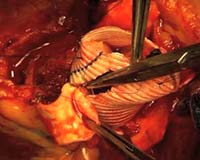We present the operative steps in the Ross procedure with pulmonary autograft reinforcement in a 16 year-old male. The patient presented with both stenotic and regurgitant congenital bicuspid aortic valve disease associated with an aneurysm of the ascending aorta.
Initially, supra-commissural ascending aorta replacement and aortic valve repair procedure were planned. Peri-operative TEE revealed the persistence of a residual, significant transvalvular gradient. A Ross procedure with pulmonary autograft reinforcement using a 24 mm Dacron conduit was then performed.
Normothermic cardiopulmonary bypass and intermittent antegrade warm blood cardioplegia were used. The result was satisfactory, and the patient was discharged home in a timely fashion.






Any developmental growth of the autograft is probably negated by the 24 mm Dacron , hence negating the main paediatric advantage of the procedure the late David Ross popularised. Is this a concern limiting the application of the Dacron re-enforcement to fully-developed adults? In the gender and age group of your patient, Devereux at al have calculated a mean diameter of the aortic root of 3.1